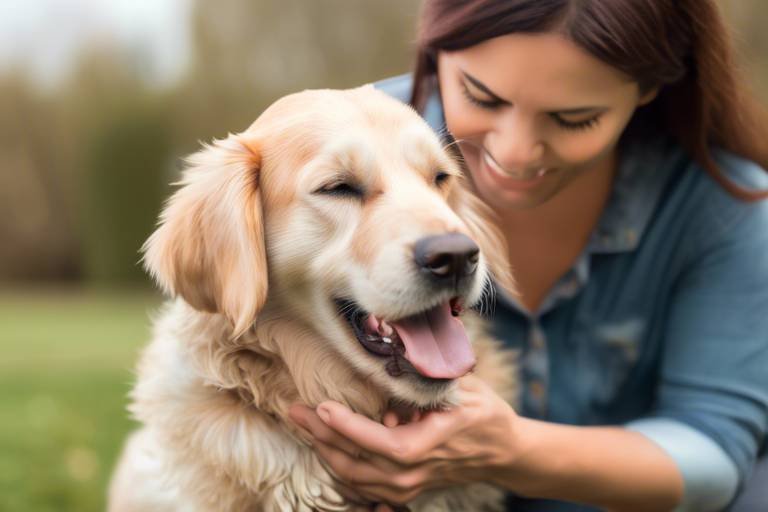How to Help Your Pet Overcome Fear of Strangers
If you’ve ever seen your beloved pet cower in the corner at the sight of a new face, you know how heart-wrenching it can be. Fear of strangers is a common issue among pets, and it can lead to a range of behavioral problems, from barking and growling to hiding and trembling. But don’t worry! With the right strategies and a bit of patience, you can help your furry friend feel more comfortable in social situations. In this article, we’ll explore effective techniques to assist your pet in overcoming their fear of strangers, fostering a more confident and relaxed demeanor.
Understanding fear in pets is the first step in addressing it. Just like humans, pets experience fear as a natural response to perceived threats. This fear can stem from past traumatic experiences, lack of socialization, or even genetic predispositions. It's crucial for pet owners to recognize the signs of fear, which can include:
- Hiding or seeking refuge
- Excessive barking or growling
- Shaking or trembling
- Avoidance behaviors
By observing these reactions, you can begin to understand your pet's emotional state and tailor your approach to help them feel secure.
Every pet has unique triggers that provoke fear. Identifying these triggers is essential for creating a plan to help your pet. Pay close attention to your pet’s behavior in various situations, noting what specifically causes them to react with fear. This could be anything from the sound of a doorbell to the sight of a person wearing a hat. Understanding these triggers allows you to gradually expose your pet to them in a controlled manner.
Dogs often react to specific stimuli that can induce anxiety. Common triggers include:
- Loud noises, such as thunder or fireworks
- Sudden movements from strangers
- Unfamiliar scents, especially from other animals
By identifying these triggers, you can work on desensitizing your dog to these stimuli over time.
Cats experience fear differently than dogs, but they also have their own set of triggers. Common fear-inducing factors for cats include:
- New environments or changes in their surroundings
- Unfamiliar sounds, like loud music or vacuum cleaners
- Sudden changes in routine
Understanding these triggers can help you create a more stable and secure environment for your feline friend.
Creating a safe space can significantly reduce a pet's anxiety. This space should be a quiet area of your home where your pet can retreat when feeling overwhelmed. Consider adding their favorite blanket, toys, and even a cozy bed to make it inviting. You can also use calming pheromones or soothing music to enhance the environment. The goal is to provide a sanctuary where your pet feels secure and can gradually acclimate to the presence of strangers.
Gradual exposure is a vital technique in desensitizing pets. This method involves slowly introducing your pet to strangers in a controlled manner. Start by having a friend or family member your pet knows well come over. Allow your pet to observe from a distance, rewarding them with treats and praise for calm behavior. Gradually decrease the distance as your pet becomes more comfortable, ensuring that each step is positive. This slow introduction can significantly help your pet build confidence.
Positive reinforcement is an effective way to encourage desired behaviors. When your pet interacts calmly with a stranger, reward them with treats or praise. This reinforces the idea that meeting new people can lead to positive outcomes. Remember, consistency is key! Regularly practicing this technique will help your pet associate strangers with good experiences.
Trust is essential for overcoming fear. Establishing a strong bond with your pet can help them feel more secure in social situations. Spend quality time together, engage in play, and provide plenty of affection. The more your pet trusts you, the more likely they are to feel safe when encountering new people. Think of it as building a bridge of trust that will lead them to a more confident and relaxed demeanor.
Sometimes, professional assistance is necessary. If your pet’s fear is severe or doesn’t improve with your efforts, it might be time to consult a veterinarian or animal behaviorist. These professionals can provide specialized support and may suggest behavior modification techniques or even medication to help your pet cope with their anxiety.
Q: How long will it take for my pet to overcome their fear?
A: Every pet is different, and the time it takes can vary. With patience and consistent training, many pets show improvement within a few weeks.
Q: Can I use medication to help my pet?
A: Yes, in some cases, medication prescribed by a veterinarian can be beneficial as part of a comprehensive treatment plan.
Q: Is it normal for pets to be afraid of strangers?
A: Yes, many pets have a natural instinct to be cautious around unfamiliar people. However, with proper training, they can learn to feel more comfortable.

Understanding Fear in Pets
Fear is a natural emotion that pets experience, just like humans do. Understanding this emotion is the first step in helping your furry friend cope with their anxiety. When pets encounter unfamiliar situations or people, their instinctual response may be to retreat or react defensively. This behavior can stem from various psychological and emotional factors, including past experiences, genetics, and their environment. Recognizing the signs of fear in pets is crucial for any pet owner, as it allows you to respond appropriately and help your pet feel more secure.
Some common signs of fear in pets include:
- Hiding or seeking shelter
- Excessive barking or vocalization
- Shaking or trembling
- Avoidance of eye contact
- Tail tucked between the legs
- Excessive licking or grooming
Understanding these behaviors can help you empathize with your pet's feelings. For instance, if your dog hides under the couch when someone new enters the room, it’s not just being rude; it’s a sign that they are overwhelmed. Similarly, a cat that suddenly bolts under the bed when the doorbell rings is expressing fear of the unknown. Just like humans, pets have their own unique ways of processing fear, and their reactions can vary widely.
Moreover, the emotional state of your pet can be influenced by their past experiences. A rescue dog, for example, may have had traumatic encounters with strangers, leading to a heightened sense of fear. On the other hand, a pet that has been socialized properly from a young age may be more inclined to approach new people with curiosity rather than fear. This is why it's essential to consider your pet's history when addressing their anxiety.
In addition to past experiences, genetics also play a significant role in how pets respond to fear. Some breeds are naturally more anxious than others, which can make them more susceptible to fear. For instance, smaller breeds like Chihuahuas may exhibit more fearful behaviors compared to larger breeds like Golden Retrievers, who are often more confident. Understanding these nuances can help you tailor your approach to your pet's specific needs.
By being aware of the psychological and emotional aspects of fear, you can better assist your pet in overcoming their anxieties. This understanding not only fosters a deeper bond between you and your pet but also equips you with the tools to create a more supportive environment. Remember, patience and empathy are key when navigating your pet's fears. After all, just like us, pets need time to adjust and feel safe in their surroundings.

Identifying Triggers
Understanding your pet's fear is an essential step towards helping them overcome it. Every animal is unique, and so are their fears. To effectively assist your furry friend, you must first identify what specifically triggers their anxiety. This process involves careful observation and a keen eye for detail. Think of it as being a detective in your pet's life, piecing together clues that reveal their fears.
When observing your pet, consider different environments and situations. Does your dog cower when a stranger approaches? Does your cat hide under the bed when there’s a loud noise? These behaviors are key indicators of what frightens them. By noting their reactions, you can begin to understand the patterns that emerge. For instance, if your dog barks at people wearing hats, that hat becomes a trigger. Similarly, if your cat hisses at the sound of a vacuum cleaner, it’s clear that the noise is a source of stress.
To make this process easier, you might want to keep a journal where you can jot down observations about your pet's behavior. This can include:
- The specific situations that cause fear
- Any physical signs of anxiety, such as trembling or hiding
- The presence of certain people or objects that provoke a reaction
Moreover, it’s important to recognize that triggers can vary not just from pet to pet, but also within the same pet depending on the context. For example, a dog may react differently to a stranger in a park compared to one at home. This variability highlights the need for a comprehensive understanding of your pet's environment and the factors that influence their behavior.
In addition, some triggers may be less obvious. For instance, a sudden change in routine or the arrival of a new family member can also induce anxiety in pets. By being proactive and identifying these triggers, you can create a tailored approach to help your pet feel more comfortable and secure. Remember, the goal is to empower them to face their fears, not to eliminate the triggers entirely, as that may not be feasible in every situation.
Ultimately, identifying triggers is a crucial first step in helping your pet overcome their fear of strangers. By understanding what makes them anxious, you can implement strategies that gradually desensitize them to these stressors, leading to a happier and more confident pet.
Common Triggers for Dogs
Understanding the common triggers that provoke fear in dogs is essential for pet owners. Dogs, much like humans, have their own unique set of fears that can stem from various stimuli in their environment. Fear can manifest in numerous ways, including barking, hiding, or even aggression. Some dogs may react to specific sounds, while others might be more sensitive to visual stimuli. By identifying these triggers, you can create a tailored approach to help your furry friend feel more at ease.
One of the most prevalent triggers for dogs is loud noises. This can include anything from thunderstorms and fireworks to the sound of vacuum cleaners or sirens. Imagine how unsettling it must be for a dog when the world suddenly erupts in a cacophony of sounds that they can't understand. They may instinctively seek shelter, often hiding under furniture or in a corner, trying to escape the overwhelming noise. Observing your dog's reaction to these sounds can help you determine how severe their fear is and what steps you might need to take to alleviate it.
Another common trigger is sudden movements. Dogs are naturally alert creatures, and unexpected actions can startle them. For instance, if a stranger approaches too quickly or makes a sudden gesture, your dog might perceive that as a threat. This is particularly true for dogs that have not been socialized properly or have had negative experiences with unfamiliar people. It’s crucial to monitor how your dog reacts when encountering new individuals, as this can provide insights into their comfort level and help you devise strategies for gradual exposure.
Additionally, unfamiliar scents can also provoke anxiety in dogs. Dogs have an extraordinary sense of smell and can detect scents that humans cannot. When they encounter new smells, especially from unfamiliar people or animals, it can trigger a fear response. This is why it’s essential to allow your dog to sniff and explore their environment at their own pace. By doing so, you’re not only providing them with an opportunity to gather information but also helping them feel more secure in their surroundings.
To summarize, here are some common triggers that can cause fear in dogs:
- Loud noises (thunder, fireworks, vacuum cleaners)
- Sudden movements (fast approaches, abrupt gestures)
- Unfamiliar scents (new people, other animals)
By recognizing these triggers, you can take proactive steps to help your dog manage their fear. It’s important to remember that every dog is different, and what may scare one dog might not affect another. The key is to be observant and patient, allowing your dog to adjust to new situations at their own pace. This understanding will not only improve your relationship with your pet but also contribute to a more relaxed and confident demeanor when faced with strangers.
Q: How can I tell if my dog is afraid?
A: Signs of fear in dogs can include trembling, hiding, barking excessively, or even aggression. Pay attention to your dog’s body language, as it can provide valuable clues about their emotional state.
Q: What should I do if my dog is afraid of strangers?
A: Gradual exposure is key. Start by introducing your dog to strangers from a distance, rewarding them with treats for calm behavior. Over time, decrease the distance as your dog becomes more comfortable.
Q: Can professional training help with my dog's fear?
A: Absolutely! A professional dog trainer or behaviorist can provide tailored strategies and techniques to help your dog overcome their fears in a safe and controlled manner.
Common Triggers for Cats
When it comes to our feline friends, understanding their fears is essential for creating a harmonious home. Cats are notoriously sensitive creatures, and their fear can often stem from various triggers that might seem innocuous to us. Just like humans, cats have their unique set of phobias, and recognizing these triggers can be the first step toward helping them feel more secure.
One of the most common triggers for cats is new environments. Imagine being whisked away to a completely unfamiliar place; the sights, sounds, and smells can be overwhelming! For cats, moving to a new home or even just rearranging furniture can lead to anxiety. They thrive on routine, and any disruption can send them into a tailspin. It's important to allow your cat time to adjust to new surroundings, giving them a safe space to retreat to while they explore at their own pace.
Another significant trigger is unfamiliar sounds. Cats have a keen sense of hearing, and loud or sudden noises can be startling. For instance, the sound of a vacuum cleaner, thunder, or even fireworks can send a cat scurrying for cover. To help mitigate this fear, try to create a calm environment during noisy events, perhaps by providing a cozy spot where they can hide away. Additionally, you can play soothing music or use white noise machines to mask sudden sounds.
Sudden changes in their environment can also trigger fear in cats. This includes anything from the arrival of new pets to changes in household dynamics, such as a new baby or a guest staying over. Cats are creatures of habit, and they often react negatively to changes that disrupt their familiar routine. If you're expecting changes in your household, it's wise to prepare your cat by gradually introducing them to new experiences. This could involve letting them sniff a new pet's bedding or allowing them to explore a new room before anyone else enters.
It's also worth noting that unfamiliar people can be a significant source of anxiety for cats. While some cats may warm up to strangers, others may view newcomers as a threat. This is especially true if the person is loud or boisterous. To help your cat feel more comfortable, consider introducing new people slowly and allowing your cat to approach them on their terms. A gentle, calm demeanor from guests can go a long way in easing your cat's fears.
Lastly, certain smells can trigger fear responses in cats. Cats have an acute sense of smell, and unfamiliar scents can be disconcerting. This includes anything from scented candles to the smell of cleaning products. To create a more inviting atmosphere, opt for unscented or naturally scented products and ensure that any strong odors are kept to a minimum.
In summary, understanding the common triggers that cause fear in cats—such as new environments, unfamiliar sounds, sudden changes, unfamiliar people, and strange smells—can greatly assist in alleviating their anxiety. By being observant and proactive, you can help your feline companion feel safe and secure in their surroundings.
- What are the signs that my cat is scared? Look for behaviors such as hiding, excessive grooming, or aggressive posturing. If your cat seems unusually withdrawn or is vocalizing more than usual, these can be signs of fear.
- How long does it take for a cat to adjust to a new environment? Each cat is different, but it can take anywhere from a few days to several weeks for a cat to feel comfortable in a new space. Patience is key!
- Can I help my cat overcome their fear of strangers? Yes! Gradual exposure, positive reinforcement, and creating a safe space can help your cat feel more comfortable around new people.

Creating a Safe Environment
Creating a safe environment for your pet is one of the most effective ways to help them overcome their fear of strangers. Just like humans, pets thrive in spaces where they feel secure and comfortable. Imagine how you would feel walking into a crowded room where you know no one; the anxiety and unease can be overwhelming. For pets, unfamiliar people can trigger similar feelings of fear and stress. Therefore, establishing a safe haven in your home can significantly reduce their anxiety levels.
First and foremost, designate a specific area in your home as your pet's sanctuary. This could be a cozy corner filled with their favorite blankets, toys, and even a bed. Ensure that this space is away from the hustle and bustle of daily activities. When strangers come over, allow your pet to retreat to this safe zone whenever they feel overwhelmed. This gives them a sense of control over their environment, which is crucial for building confidence.
Another essential aspect of creating a safe environment is to manage the sounds and sights that might trigger your pet's fear. For instance, if your dog is sensitive to loud noises, consider using white noise machines or calming music to drown out sudden sounds. Similarly, for cats who may be startled by sudden movements or unfamiliar scents, try to minimize exposure to such stimuli. You could use curtains to block the view of the outside world or place calming pheromone diffusers around the house.
It's also important to establish a routine. Pets are creatures of habit, and having a consistent daily schedule can provide them with a sense of stability. Feed them at the same times each day, take them for walks regularly, and engage in playtime consistently. This predictability helps them feel more secure and less anxious, making it easier for them to cope when they encounter strangers.
Lastly, consider incorporating some calming products into your pet's environment. There are various options available, such as anxiety wraps, calming treats, and even specialized pet beds designed to provide comfort. These products can be particularly helpful during stressful situations, like when guests arrive. However, always consult your veterinarian before introducing any new products to ensure they're suitable for your pet.
In summary, creating a safe environment for your pet involves:
- Designating a cozy sanctuary space.
- Managing external stimuli like noise and sight.
- Establishing a consistent routine.
- Incorporating calming products as needed.
By taking these steps, you can help your pet feel more comfortable and secure, which is a vital foundation for overcoming their fear of strangers.

Gradual Exposure Techniques
When it comes to helping your pet overcome their fear of strangers, can be a game changer. Think of this method as a gentle introduction to the big, scary world outside your home. Just like how we wouldn't throw a child into the deep end of a pool without teaching them to swim first, pets need a gradual approach to feel comfortable around unfamiliar faces. This technique involves slowly introducing your pet to strangers in a controlled manner, allowing them to adjust at their own pace.
To start, it's essential to create a calm and safe environment. Begin by having a friend or family member visit your home, but don't force your pet to interact right away. Allow them to observe from a distance. You might notice your pet's ears perk up or their body language shift as they take in this new person. This initial observation phase is crucial, as it helps your pet feel secure while they assess the situation. Remember, patience is key here; rushing the process can lead to setbacks.
As your pet becomes more comfortable, you can gradually decrease the distance between them and the stranger. This could mean having your friend sit on the floor while you hold your pet on a leash, allowing them to feel secure while still being able to explore this new interaction. If your pet shows signs of distress, like whining or hiding, don’t panic! Just take a step back and give them some space to breathe. You can also use treats to create positive associations. For example, each time your pet looks at the stranger without showing fear, reward them with a treat. This reinforces the idea that strangers can be a source of good things!
Here’s a simple outline of the steps you might follow:
- Step 1: Introduce the stranger from a distance.
- Step 2: Allow your pet to observe and get comfortable.
- Step 3: Gradually decrease the distance while monitoring your pet's comfort level.
- Step 4: Use treats and praise to reward calm behavior.
- Step 5: If your pet shows signs of stress, back off and try again later.
Another effective technique is to incorporate controlled outings. Take your pet to a quiet park where they can see people from a distance. This way, they can observe strangers in a less intimidating environment. Gradually bring them closer to the action as they become more confident. Remember to keep these outings short and positive to avoid overwhelming them.
Incorporating playtime can also be beneficial. Engaging your pet in their favorite activities while a stranger is present can create a positive distraction. They’ll associate the presence of new people with fun and excitement rather than fear. You can even ask the stranger to toss a toy or treat your way, reinforcing that strangers can be fun too!
Ultimately, the goal is to help your pet build a positive association with strangers. With time, patience, and consistent practice, your pet will learn that there’s nothing to fear. Remember, every pet is unique, so adjust these techniques to fit your furry friend’s personality and comfort level. The journey may be long, but the reward of seeing your pet confidently greet new people is well worth the effort!
Q: How long does it take for a pet to overcome their fear of strangers?
A: The timeline varies depending on the individual pet and their past experiences. Some may adjust in a few weeks, while others might take several months. Consistency and patience are key!
Q: Can I use toys or treats to help my pet feel more comfortable?
A: Absolutely! Using toys and treats can create positive associations with strangers. Just ensure that the treats are given during calm moments to reinforce good behavior.
Q: What should I do if my pet becomes aggressive towards strangers?
A: If your pet shows aggressive behavior, it’s best to consult a professional trainer or behaviorist. They can provide tailored strategies to address aggression safely.
Q: Are there any specific breeds that are more prone to fear of strangers?
A: While any dog or cat can develop a fear of strangers, some breeds may be more sensitive due to their temperament. It's essential to understand your pet's unique needs.
Using Positive Reinforcement
When it comes to helping your pet overcome their fear of strangers, positive reinforcement is a game changer. Think of it as a way to turn fear into confidence, one treat at a time! By rewarding your pet for calm behavior in the presence of strangers, you not only encourage them to face their fears but also build a stronger bond between you and your furry friend. It’s like teaching a child to ride a bike; a little encouragement goes a long way!
So, how does positive reinforcement work in practice? The idea is simple: when your pet behaves in a way that you want to encourage, you reward them immediately. This could be through treats, praise, or even playtime. The key is to ensure that the reward is something your pet truly enjoys. For instance, if your dog loves peanut butter, use it as a treat during training sessions. The association between the positive experience and the presence of strangers will gradually help them feel more at ease.
Here are some effective strategies to implement positive reinforcement:
- Start Small: Begin with a distance where your pet feels comfortable. For example, if your dog is nervous around new people, have a friend stand far away. Reward your pet for calm behavior.
- Gradual Approach: Slowly decrease the distance between your pet and the stranger over multiple sessions. Each time your pet remains calm, reward them generously!
- Consistency is Key: Make sure to reward every time your pet exhibits positive behavior. The more consistent you are, the quicker they will learn that strangers aren't a threat.
It's also important to note that timing is crucial. The reward must come immediately after the desired behavior; otherwise, your pet may not connect the dots. Imagine telling a child they did well in school a week later—it's just not as effective! Additionally, be patient. Some pets may take longer than others to adjust, and that’s perfectly okay. Remember, every small victory counts!
Finally, don't underestimate the power of your voice and demeanor. Using a cheerful tone and a relaxed body language can significantly influence your pet's perception of the situation. Your enthusiasm can be contagious! So, the next time you’re helping your pet face their fears, channel your inner cheerleader and watch as they start to gain confidence.
Building Trust with Your Pet
Building trust with your pet is akin to nurturing a delicate flower; it requires patience, consistency, and a sprinkle of love. Just like humans, pets thrive on affection and security. When a pet feels safe and understood, they are more likely to open up and face their fears head-on. So, how do we cultivate this trust? Well, it starts with understanding their needs and providing a stable environment.
First and foremost, spending quality time with your pet is essential. This means engaging in activities they enjoy, whether it’s a game of fetch with your dog or gentle playtime with your cat. These interactions not only strengthen your bond but also help your pet associate you with positive experiences. Think of it as building a bridge; every moment spent together is a plank that makes that bridge stronger.
Moreover, it’s important to listen to your pet. Animals communicate in their unique ways, and being attuned to their body language can reveal a lot about their emotional state. For instance, a wagging tail doesn’t always mean happiness; it can also indicate nervousness in certain contexts. By observing their reactions and respecting their boundaries, you're showing your pet that you care about their feelings, which is a crucial step in trust-building.
Consistency is another pillar in this process. Establishing a routine can significantly reduce anxiety for pets. Feeding them at the same time each day, scheduling regular play sessions, and maintaining a predictable environment can help them feel more secure. Just like we find comfort in routine, pets do too. It’s their way of knowing what to expect, which can alleviate their fears in unfamiliar situations.
Additionally, positive reinforcement plays a pivotal role in building trust. When your pet exhibits brave behavior, like approaching a stranger or exploring a new area, reward them! This could be through treats, praise, or a favorite toy. It’s like giving them a high-five for their courage. Over time, they will start to associate new experiences with positive outcomes, which can help diminish their fear.
Lastly, remember that patience is key. Trust is not built overnight; it’s a gradual process. Celebrate the small victories along the way, and don’t rush your pet into situations that make them uncomfortable. Just like a beautiful symphony, building trust takes time and practice. Each note matters, and together they create a harmonious relationship that can withstand the challenges of fear and anxiety.
- How long does it take to build trust with a fearful pet?
Trust-building can vary greatly depending on the individual pet and their past experiences. It can take anywhere from a few weeks to several months. The key is to remain patient and consistent. - What if my pet doesn't respond to positive reinforcement?
Every pet is unique. If your pet doesn't seem motivated by treats, try using their favorite toy or engaging in a beloved activity as a reward. - Are there specific breeds that are more fearful than others?
While any pet can experience fear, some breeds are more predisposed to anxiety due to their temperament. It's essential to understand your pet's breed characteristics and adjust your approach accordingly.

Seeking Professional Help
Sometimes, despite our best efforts, our furry friends may still struggle with their fear of strangers. In such cases, seeking professional help can be a game-changer. It's essential to recognize when your pet's anxiety goes beyond typical shyness or nervousness. If your pet exhibits extreme fear responses, such as excessive barking, hiding, or aggression, it might be time to consult a professional. But who should you turn to? Here are some options:
- Veterinarians: Your first stop should be your vet. They can rule out any underlying medical issues that might be contributing to your pet's anxiety. Sometimes, physical discomfort can manifest as fear.
- Animal Behaviorists: These experts specialize in understanding animal behavior and can provide tailored strategies to help your pet overcome their fears. They often use a combination of training techniques and behavioral modification.
- Certified Dog Trainers: If your pet is a dog, a certified trainer can help you implement specific training techniques to manage your dog’s fear. Look for trainers who use positive reinforcement methods.
When you reach out for professional help, be prepared to provide detailed information about your pet's behavior. Keeping a journal of their reactions to different situations can help the professional understand your pet's triggers better. This record should include:
| Date | Trigger | Response | Duration |
|---|---|---|---|
| 01/10/2023 | New person at the door | Barking and hiding | 10 minutes |
| 01/12/2023 | Stranger in the park | Growling and backing away | 5 minutes |
Additionally, don't hesitate to ask questions during your consultation. Understanding the methods and rationale behind the recommended strategies will empower you to assist your pet effectively. Remember, your goal is to create a supportive environment where your pet can feel safe and gradually learn to trust strangers.
In some instances, a veterinarian may recommend medication to help manage your pet's anxiety. While this can be a helpful tool, it should always be used in conjunction with behavioral training. Think of it as a safety net that allows your pet to engage more comfortably in training sessions.
Overall, seeking professional help is not a sign of failure; rather, it demonstrates your commitment to your pet's well-being. Every pet is unique, and sometimes, a little extra support is all they need to thrive in social situations. With the right guidance, you can help your pet conquer their fears and enjoy a more fulfilling life.
Frequently Asked Questions
- What are the signs that my pet is afraid of strangers?
Pets often show fear through body language. Look for signs like cowering, hiding, excessive barking, or even growling. Some pets might also try to escape or avoid eye contact. Recognizing these signs early can help you address their fears more effectively.
- How can I identify my pet's specific triggers?
To identify triggers, observe your pet's behavior in different situations. Take note of what causes them to react fearfully. Is it loud noises, sudden movements, or unfamiliar people? Keeping a journal of these observations can help you pinpoint what specifically scares your pet.
- What steps can I take to create a safe environment for my pet?
Creating a safe space involves providing a quiet area where your pet can retreat when feeling scared. Use familiar blankets or toys to make this space comforting. Ensure that this area is away from the hustle and bustle of strangers and loud noises.
- How does gradual exposure work in helping pets overcome fear?
Gradual exposure involves slowly introducing your pet to their fears in a controlled manner. Start with low-stress situations, like having a friend approach while keeping a distance. Gradually decrease the distance as your pet becomes more comfortable, rewarding them with treats and praise along the way.
- What role does positive reinforcement play in this process?
Positive reinforcement is crucial! By rewarding your pet with treats or praise when they remain calm around strangers, you help them associate these encounters with positive experiences. This builds their confidence and encourages them to face their fears.
- When should I consider seeking professional help for my pet?
If your pet's fear is severe and they exhibit aggressive behavior or extreme anxiety, it may be time to consult a veterinarian or an animal behaviorist. They can provide tailored strategies and, if necessary, medication to help your pet cope with their fears.



















